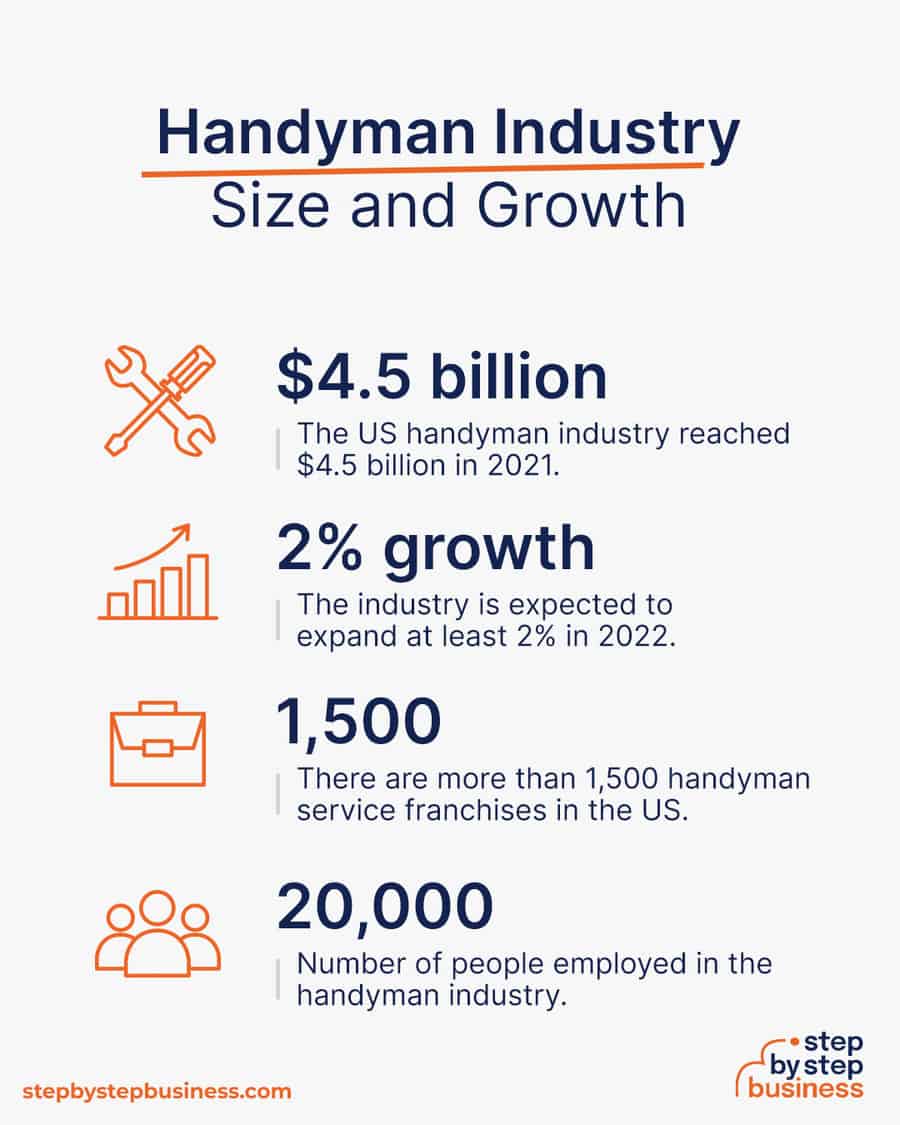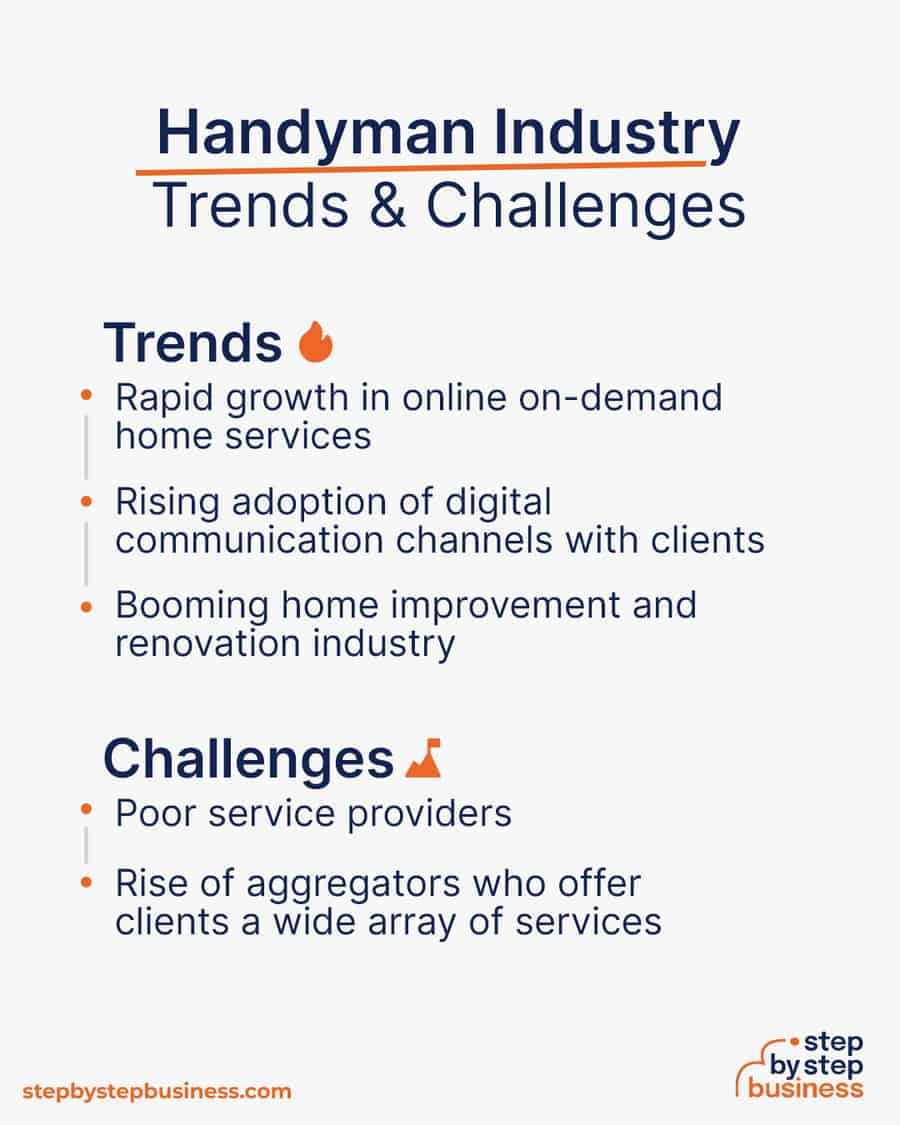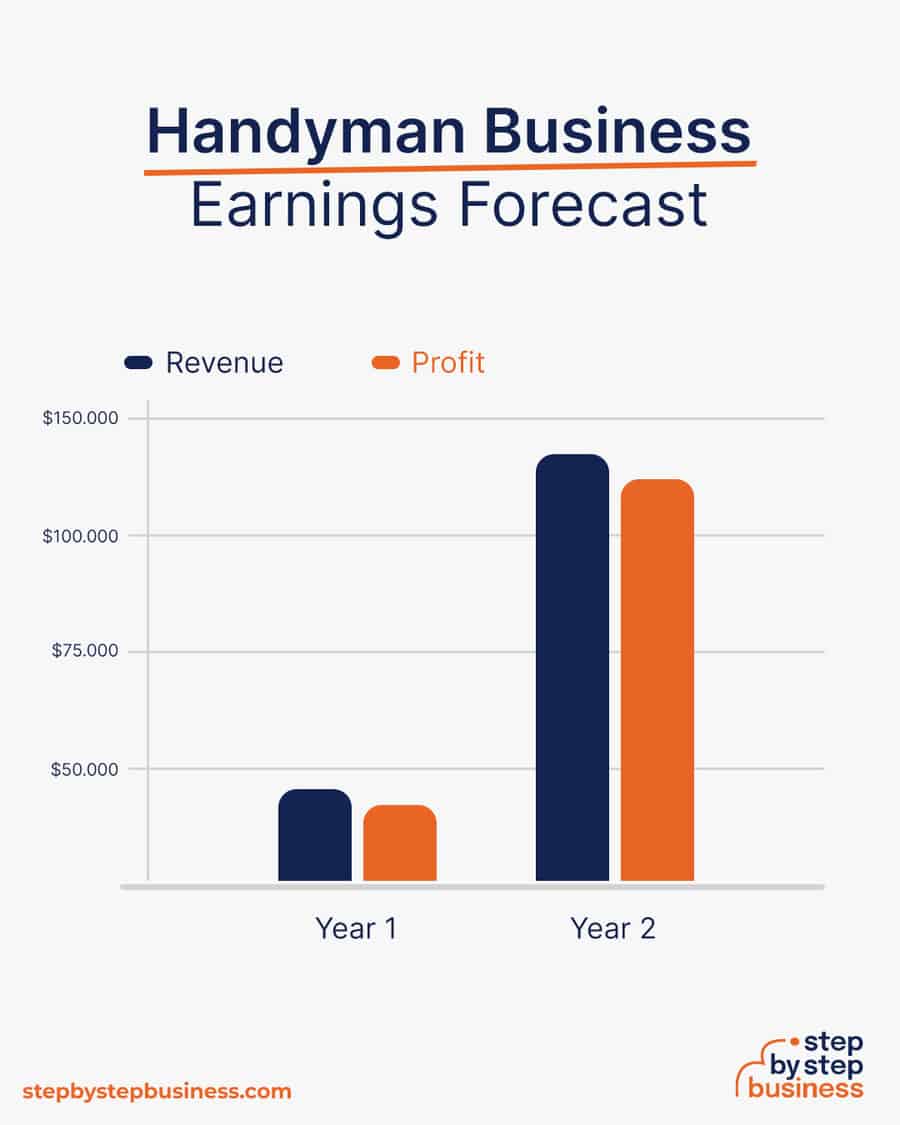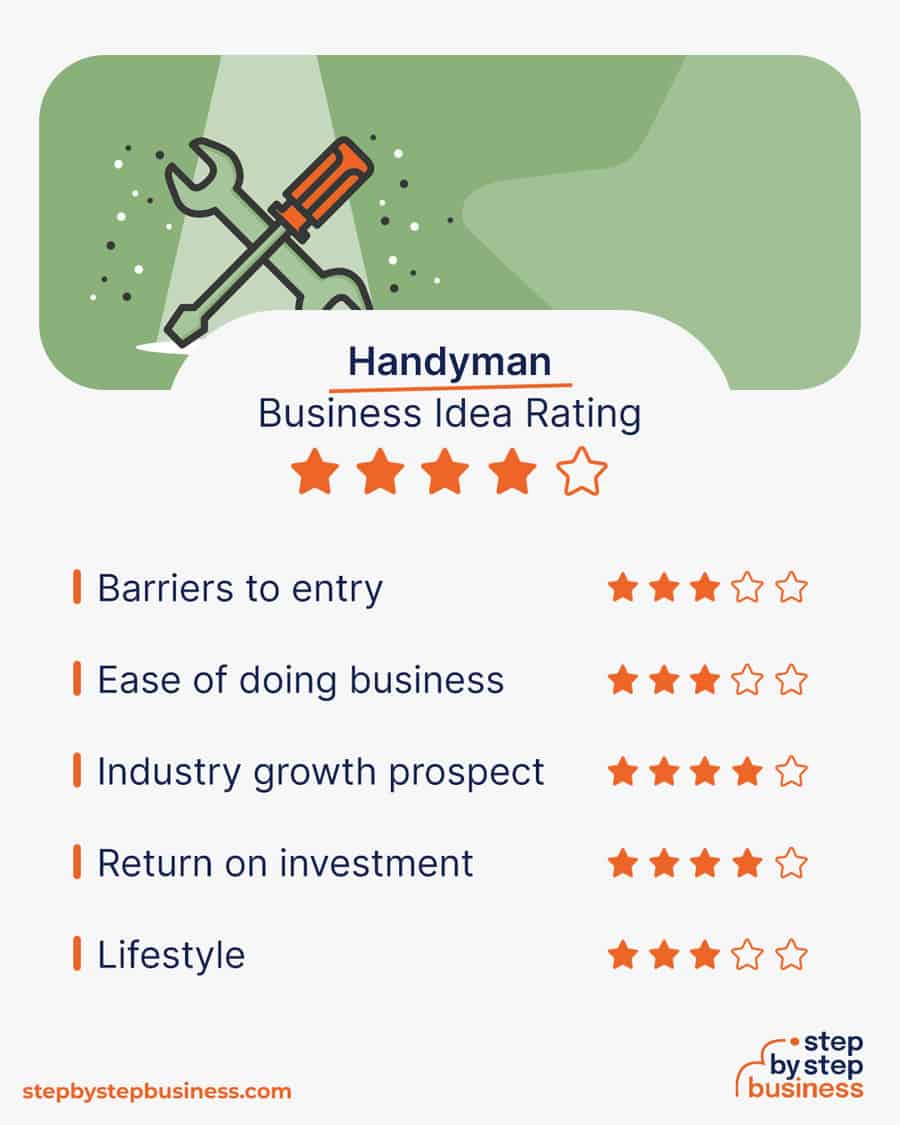Find aDomain Search Powered byGoDaddy.com ...
You might consider targeting a niche market by specializing in a certain aspect of your industry, such as being a handyman for a large residential compound.
We earn commissions if you shop through the links below. Read more
Written by: Carolyn Young
Carolyn Young has over 25 years of experience in business in various roles, including bank management, marketing management, and business education.
Published on October 15, 2021
Updated on September 22, 2022

Investment range
$2,300 - $5,900
Revenue potential
$39,000 - $135,000 p.a.
Time to build
0 - 3 months
Profit potential
$35,000 - $122,000 p.a.
Industry trend
Growing
Commitment
Full-time
Homeowners and businesses are using handyman services more and more these days. If you are skilled at making repairs, and doing other work like painting, drywall, carpentry, and more, starting a handyman business could be a great opportunity for you to build a profitable company.
Starting any kind of business, however, takes a lot of work. The key is to have the knowledge that you need before you start so that you avoid common mistakes. This step-by-step guide provides all the information and insight you need to start and build a profitable business.

Starting a handyman business requires time and effort. Before you jump in, you need to fully understand what is involved before you decide if a handyman business is right for you.
The overall home services industry size was valued at $105 billion in 2018 and is projected to reach $1.2 trillion by 2026.((https://www.verifiedmarketresearch.com/product/us-home-service-market/))
Market growth has been driven by more spending on home improvements and is expected to continue as the pandemic recedes. Overall, the industry is sensitive to economic fluctuations because when consumers have less disposable income, they delay non-critical home repairs.

Trends in the handyman industry include:
Challenges in the handyman industry include:


Start-up costs for a handyman business range from $2,300 to $5,900. Tools and a website are the largest investments. Buying second-hand tools can help cut costs, as can building your own website.
| Start-up Costs | Ballpark Range | Average |
|---|---|---|
| Setting up a business name and corporation | $100 - $300 | $200 |
| Business licenses and permits | $200 - $300 | $250 |
| Insurance | $100 - $500 | $300 |
| Business cards and brochures | $200 - $300 | $250 |
| Website setup | $1,000 - $3,000 | $2,000 |
| Initial marketing budget | $200 - $500 | $350 |
| Tools | $500 - $1,000 | $750 |
| Total | $2,300 - $5,900 | $4,100 |
Your profits will vary depending on:
The cost to provide services is minimal if you pass on the cost of any materials to the customer. You should average about $50 per hour, and with minimal costs have a profit margin of around 90%.
In your first year or two, you might work 15 hours per week, which would give you $39,000 in annual revenue and a profit of about $35,000.
As your brand gains recognition and you begin to get referrals and repeat customers, you could get to 40 hours per week and start charging $65 per hour. You would make $135,000 in annual revenue and about $122,000 in profit.
If you eventually grow your business enough that you can hire other handymen to work for you, you could increase your income considerably.

There are very few barriers to entry for a handyman business. Your biggest challenges will be:

Now that you know what is involved in starting a handyman business, you need to hone your idea in order to be able to enter a new market with tough competition.
Research handyman businesses in your area to examine their services, price points, and customer reviews. You’re looking for a market gap to fill. For instance, maybe the local market is missing a handyman who can also do electrical work or plumbing.
You might consider targeting a niche market by specializing in a certain aspect of your industry, such as being a handyman for a large residential compound.
This could jumpstart your word-of-mouth marketing and attract clients right away.
Make a list of all the skills that you have and turn that into a comprehensive list of all the services you can provide. If you are a licensed electrician or plumber, you can use that in your marketing and charge higher prices for those services. Be sure to list all of your services on your website. If there are any gaps in your skills, start to fill those gaps by learning new skills. The more you can do, the more business you can get.
When you are just starting out, you may have to charge a lower-than-average price until you have a track record. You should probably start out charging $50 an hour and increase that as you build a reputation. Research other handyman services in your area to determine prices in your local market.
Once you know your costs, you can use this Step By Step profit margin calculator to determine your mark-up and final price points. Remember, the prices you use at launch should be subject to change if warranted by the market.
Your target market will be mainly homeowners, but you can market to businesses as well. One way to reach homeowners is to market to real estate agents so that they can refer you to their home buyers and sellers. You can also search sites like Facebook, Instagram and LinkedIn.
After you get started, word-of-mouth referrals will be your biggest source of business.
In the early stages of your business development, you can operate your business from home to help you keep your overhead expenses in check.
However, as your business grows and operations intensify, you may hire workers for various job roles and rent out an office. Find commercial space to rent in your area on sites such as Craigslist, Crexi, and Instant Offices.
When choosing a commercial space, you may want to follow these rules of thumb:


Your business name is your business identity, so choose one that encapsulates your objectives, services, and mission in just a few words. You probably want a name that’s short and easy to remember, since much of your business, and your initial business in particular, will come from word-of-mouth referrals.
Here are some ideas for brainstorming your business name:
Once you’ve got a list of potential names, visit the website of the US Patent and Trademark Office to make sure they are available for registration and check the availability of related domain names using our Domain Name Search tool. Using “.com” or “.org” sharply increases credibility, so it’s best to focus on these.
Finally, make your choice among the names that pass this screening and go ahead with domain registration and social media account creation. Your business name is one of the key differentiators that set your business apart. Once you pick your company name, and start with the branding, it is hard to change the business name. Therefore, it’s important to carefully consider your choice before you start a business entity.
Every business needs a plan. This will function as a guidebook to take your startup through the launch process and maintain focus on your key goals. A business plan also enables potential partners and investors to better understand your company and its vision:
If you’ve never created a business plan, it can be an intimidating task. You might consider hiring a business plan specialist at Fiverr to create a top-notch business plan for you.

Registering your business is an absolutely crucial step — it’s the prerequisite to paying taxes, raising capital, opening a bank account, and other guideposts on the road to getting a business up and running.
Plus, registration is exciting because it makes the entire process official. Once it’s complete, you’ll have your own business!
Your business location is important because it can affect taxes, legal requirements, and revenue. Most people will register their business in the state where they live, but if you are planning to expand, you might consider looking elsewhere, as some states could offer real advantages when it comes to handyman work.
If you’re willing to move, you could really maximize your business! Keep in mind, it’s relatively easy to transfer your business to another state.
There are different ways to structure a business, and each has some pros and cons. The legal structure you choose for your handyman business will impact your business registration requirements, how much you pay in taxes, and your personal liability.
Here are the main options:
We recommend that new business owners choose LLC as it offers liability protection and pass-through taxation while being simpler to form than a corporation. You can form an LLC in as little as five minutes using ZenBusiness’s online LLC formation service. They will check that your business name is available before filing, submit your articles of organization, and answer any questions you might have.

The final step before you’re able to pay taxes is getting an Employer Identification Number, or EIN. You can file for your EIN online or by mail or fax: visit the IRS website to learn more. Keep in mind, if you’ve chosen to be a sole proprietorship you can simply use your social security number as your EIN.
Once you have your EIN, you’ll need to choose your tax year. Financially speaking, your business will operate in a calendar year (January–December) or a fiscal year, a 12-month period that can start in any month. This will determine your tax cycle, while your business structure will determine which taxes you’ll pay.
The IRS website also offers a tax-payers checklist, and taxes can be filed online.
It is important to consult an accountant or other professional to help you with your taxes to ensure you are completing them correctly.
Securing your funds is your next step and there are plenty of ways you can raise the capital.
Bank and SBA loans are probably the best options, other than friends and family, for funding a handyman business. You might also try crowdfunding if you have an innovative concept.


To start a new business, you will have to obtain a number of licenses and permits from the local, state, and federal governments.
Federal regulations, licenses, and permits associated with starting a handyman business include doing business as (DBA), trademarks, copyrights, patents, and other intellectual properties (IPs), as well as industry-specific licenses and permits if required.
You may need licenses to do various types of work such as electrical and plumbing. Check with your state and local government for requirements. Getting a contractor’s license, even if it is not required, would give you credibility with customers.
Additional permits may be required by your state to allow your handyman business to function legally, such as a general business permit and basic business license. The license requirements and how to obtain them may vary from state to state. You should check your state’s official site or contact the appropriate person to inquire about licenses and permits that you need to run a handyman business.
Your city, town, or county may also have legal and compliance requirements for a handyman business, such as sign permit, fire department permit, building and home occupation permit, and planning and zoning permit. You should speak to the designated representative of your local government and inquire about the licensing requirement for your business.
You could also check this SBA guide for your state’s requirements, but we recommend using MyCorporation’s Business License Compliance Package. They will research the exact forms you need for your business and state and provide them to ensure you’re fully compliant.
This is not a step to be taken lightly, as failing to comply with legal requirements can result in hefty penalties.
If you feel overwhelmed by this step or don’t know how to begin, it might be a good idea to hire a professional to help you check all the legal boxes.
Before you start making money, you’ll need a place to keep it, and that requires opening a bank account.
Keeping your handyman business’s finances separate from your own personal account makes it easy to track how your company is doing and keeps things simple when it comes to filing taxes and a profit and loss statement when the time comes, so it’s worth doing even if you’re running your business as a sole proprietorship.
Opening a business bank account is not very difficult and is similar to opening a personal one. Most major banks will offer business account options, so you can inquire at the local banks to understand the different rates and features.
It’s important to look at a few options since they can vary quite a bit in what they offer, and you will want to get the best rate. Once you decide on the right bank, you just need to bring your EIN (or Social Security Number if you decide on a sole proprietorship), and your articles of incorporation or other legal documentation showing that your business is registered.
Business insurance is an area that often gets overlooked but is vital to your success as an entrepreneur. Insurance protects you from those unexpected events that can have a devastating effect on your life and business.
Here are some of the different types of insurance to think about and consider whether it is right for you and your business:


As you approach your opening day, there are a few ways to get prepared for the launch! These are some of the last steps to take to ensure you are ready to get started.
Being an entrepreneur can mean taking on a lot of different roles and functions, from marketing to accounting. It can get overwhelming and difficult to manage so many diverse activities! Luckily there are a lot of excellent software programs and tools to help you with specific business tasks.
You may want to use tools like Jobber, Housecall Pro, and WorkWave to manage your schedule and customers, receive payments and issue invoices, and more.
Some of your business will come from word-of-mouth customers or online visitors, but you should still invest in digital marketing! Getting the word out is especially important for new businesses, as it’ll boost customer and brand awareness.
Once your website is up and running, link it to your social media accounts and vice versa. Social media is a great tool for promoting your business because you can create engaging posts that advertise your products:
Take advantage of your website, social media presence and real-life activities to increase awareness of your offerings and build your brand. Some suggestions include:
Website development is crucial because your site is your online presence and needs to convince prospective clients of your expertise and professionalism. They are unlikely to find your website, however, unless you follow Search Engine Optimization (SEO) practices. These are steps that help pages rank higher in the results of top search engines like Google.
You can create your own website using services like WordPress, Wix, or Squarespace. This route is very affordable, but figuring out how to build a website can be time-consuming. If you lack tech-savvy, you can hire a web designer or developer to create a custom website for your business.
Unique selling propositions, or USPs, are the characteristics of a product or service that sets it apart from the competition. Customers today are inundated with buying options, so you’ll have a real advantage if they are able to quickly grasp how your handyman services meet their needs or wishes. It’s wise to do all you can to ensure your USPs stand out on your website and in your marketing and promotional materials, stimulating buyer desire.
Global pizza chain Domino’s is renowned for its USP: “Hot pizza in 30 minutes or less, guaranteed.” Signature USPs for your handyman business could be:

You may not like to network or use personal connections for business gain. But your personal and professional networks likely offer considerable untapped business potential. Maybe that Facebook friend you met in college is now running a handyman business, or a LinkedIn contact of yours is connected to dozens of potential clients. Maybe your cousin or neighbor has been working as a handyman for years and can offer invaluable insight and industry connections.
The possibilities are endless, so it’s a good idea to review your personal and professional networks and reach out to those with possible links to or interest in handyman work. You’ll probably generate new customers or find companies with which you could establish a partnership. Online businesses might also consider affiliate marketing as a way to build relationships with potential partners and boost business.

You may not need to hire any employees if you are starting out small from a home-based office. However, as your business grows, you may need to recruit full-time employees for various job roles, such as:
At some point, you may need to hire all of these positions or simply a few, depending on the size and needs of your business. You might also hire multiple workers for a single role or a single worker for multiple roles, again depending on need.
Free-of-charge methods to recruit employees include posting ads on popular platforms such as LinkedIn, Facebook, or Jobs.com. You might also consider a premium recruitment option, such as advertising on Indeed, Glassdoor, or ZipRecruiter. Further, if you have the resources, you could consider hiring a recruitment agency to help you find talent.

You’ve now got all the knowledge you need to start your handyman business. It’s time to get out there and start fixing your way to a bright entrepreneurial future. You’ll not only have the freedom to work at your own pace, but you’ll also be able to earn a tidy income.
As homeowners become more confident in spending for house repairs and maintenance, you can expect bigger demand for handyman services. So brush up on your networking skills and find your first customer. If you do this right, you’ll soon be able to scale your business and enjoy a profitable career!
What services you can provide will depend on licenses required in your area. For example, electrical and plumbing work generally require licenses, as does anything that affects the structure of a home. Some types of work require a contractor’s license. Check with your state and local governments for requirements.
Profit margins for a handyman business are high, particularly when you are doing it on your own. You could make a six-figure profit just working as a solopreneur.
You could start a handyman business for a little more than $2,000. If you already have tools and can build your own website, your costs will be even lower.

Published on August 16, 2023
Find aDomain Search Powered byGoDaddy.com ...
Read Now

Published on March 16, 2023
Lorem ipsum dolor sit amet, consectetur adipiscing elit, sed do eiusmod tempor incididunt ut labore et dolore magna aliqua. Ut enim ad minim veniam, ...
Read Now

Published on March 10, 2023
When to Use Paychex Flex When to Use QuickBooks Payroll ...
Read Now
No thanks, I don't want to stay up to date on industry trends and news.
Comments